

 The South African
The South African
Some historically valuable exhibits were recently presented to the Museum by Dr W. S. Finsen, past director of the Republic (previously Union) Observatory. The interesting notes which follow were provided by Dr Finsen and make a fine historical record.
HISTORICAL NOTES
In September 1941 the Observatory was approached by
the UDF with a request for diagrams for adapting a simple
sun compass, then in use by armoured fighting vehicles in
North Africa, to South African latitudes for training purposes.
This “instrument” employed a vertical gnomon and
a set of paper diagrams showing the direction of the shadow
cast by the gnomon at different latitudes, dates and local
apparent times. A variation was the “Cole Pattern” which
was more sophisticated but employed the same principle:
in place of a set of paper diagrams there was a brass plate
with an intersecting set of hyperbolas and parabolas
engraved on it. In the case of both instruments, it was necessary
to make continual allowance for the passage of time, and,
inevitably, the accuracy was low.
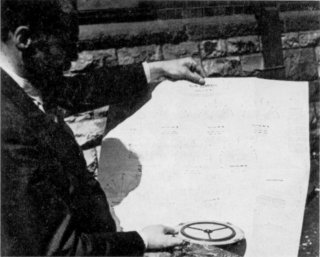
Sun compass with vertical gnomon
and paper shadow diagrams for
different latitudes and dates,
as used by Armoured Fighting
Vehicles in North Africa.
It was a request for similar diagrams
calculated for South Africa for
training purposes that prompted
Dr Finsen to design a better and
more accurate universal sun compass.
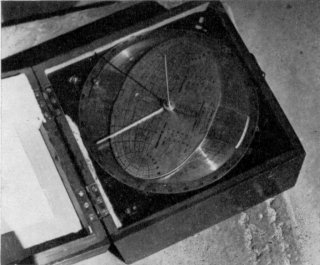
Cole pattern sun compass
also used in North Africa.
I was surprised that such rough-and-ready devices were relied on and suggested that we might be able to devise something better. Dr. W. H. van den Bos and I put our heads together and came up with an idea of which I proceeded to make a wooden mock-up, purely to demonstrate the principle and with no great emphasis on accuracy. When this was demonstrated to the UDF representatives, they were so interested that they insisted on an immediate test under field conditions, notwithstanding my demur that the wooden model was intended purely for demonstration of the principle and its accuracy could not be guaranteed. Accordingly a small expedition set out (September 23-26, 1941) for Mafeking to test the instrument in the thick bush country west of that town, between Jan Masibi and Logaging. In the rush, as no arrangement had been made for mounting the sun compass on the vehicle, it was necessary to stop the car from time to time, set the sun compass up on a camera tripod, level it as accurately as possible without a spirit level, and memorize the furthest bush in the required direction. As the visibility was often as low as 400 yards, this had to be done about 60 times. Furthermore, the sky was veiled with high, thin cloud and it was, therefore, very difficult to see the image of the sun formed by the pinhole (and for this reason a lens was incorporated in the final design).
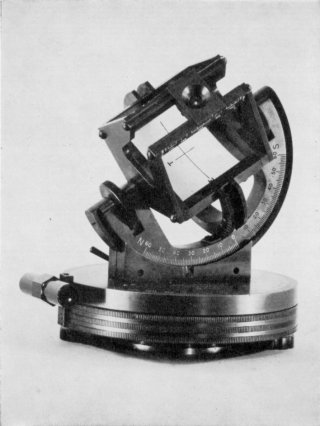
Union Observatory
Universal Sun Compass.
It is of interest to note that several members of the expedition (including a representative of the British Military Mission) used prismatic compasses to check the sun compass bearings with which they differed consistently. However, I was not unduly worried as I knew that it was a magnetically disturbed region.
When we had travelled approximately 40 miles (the distance from Jan Masibi to Logaging), we looked for a pair of tall trees which we knew marked the position of Logaging. The officers with prismatic compasses, convinced that we had veered to the north, searched the horizon with their glasses pointed well to the south, but did not see the trees. Then someone else searched well to the north, but also saw nothing. At this, I climbed on the roof of the car, and with the glasses picked up the trees almost dead ahead. The official report stated: “The vehicle arrived 350 yards from the objective. The test has conclusively demonstrated the practicability and accuracy of the instrument.” So high an accuracy with so hurriedly contrived and make-shift an instrument used under the most adverse conditions undoubtedly had an element of good luck.
I then proceeded to design the instrument in its final form with the invaluable assistance of Mr L. V. Holmgren of the Trigonometrical Survey Office. It is appropriate to mention here that it is to the enthusiasm and energetic support of Col. H. A. Baumann that most of the credit should go for the success of the final instrument.
An immediate problem was the design of a simple (and cheap) lens with acceptably small field distortion. My success in this resulted in a wholly unwarranted reputation as an expert in optical design which led to my secondment to the Instrument and Wireless Section of the Directorate of War Supplies.
On acceptance of a satisfactory design, an order was eventually placed for approximately 100 instruments. The work was carried out partly in Cape Town (at the TSO) and partly in Johannesburg. The final assembly and calibration was done by a small team under my supervision in the workshops of the instruments and Wireless Section, Chrysler House, Johannesburg. The completed instruments were tested by a representative of the Department of Technical Inspection, DGS, on known azimuth marks from the roof of Chrysler House; the allowed tolerance in true bearing was a quarter of a degree.
The theory and use of the sun compass was described in a Handbook on the Union Observatory Universal Sun Compass (Deputy Chief of Staff (Survey Sub-section) D.H.Q., Union Defence Force, Technical Phamphlet No. 3, U.D.F. Misc./356, Pretoria, November, 1943). The three basic methods of use are described in detail, viz.:
“E” Method which does not involve knowledge of the time.
Not applicable near noon or in high latitudes.
“T” Method, applicable in high latitudes and near
noon in low latitudes, and requires knowledge of the time
(Local Apparent Time). However, in low latitudes the
sun compass itself may be used earlier in the morning to
set a watch directly to L.A.T. for subsequent use near
noon without knowledge of longitude or equation of time.
“Z” Method, combination of the “E” and “T” Methods,
giving the greatest possible accuracy.
The Handbook also covers in considerable detail: Technical Data, Astronomical Theory, Mathematical Theory (Relative Accuracy of “E” and “T” Methods, Theory of Errors).
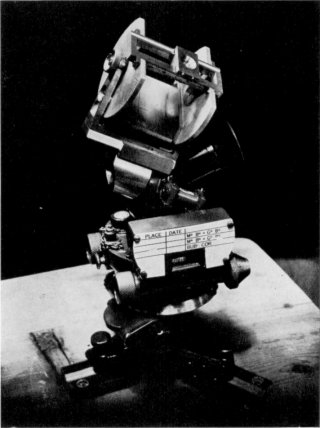
Precision model Union Observatory
sun compass for use with Gun Director.
Precision (Artillery) Model
At a rather late stage in the war, Col. Baumann urged me
to explore the possibility of designing and manufacturing a
sun compass with an accuracy of the order of several minutes
of arc for use directly in laying guns, thus obviating
complicated survey methods. The idea was to design it as an
attachment to a standard Gun Director and so make use of
already existing accurate azimuth and altitude “circles”
(actually worms and worm-wheels), telescope, bubble, etc.
I was rather doubtful of the feasibility of this but agreed to
try. With the rather limited resources of the Chrysler House
I & W, DGS workshop, I succeeded in making such an
attachment for a Gun Director borrowed for the purpose,
which seemed to justify Col. Baumann’s optimism, yielding
true bearings with errors of the order of one or two minutes
of arc when used by the correct method. Subsequently, the
TSO (Cape Town) made two or three “Chinese copies”,
one of which, when attached to a small theodolite, gave even
better results. The latter, incidentally, was used for laying
out the meridian for a telescope at the Observatory’s
Hartebeespoort Annexe, giving in a few minutes a better
determination than a day’s conventional observing with a theodolite.
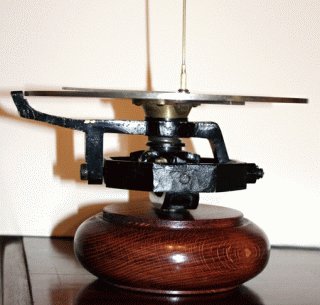
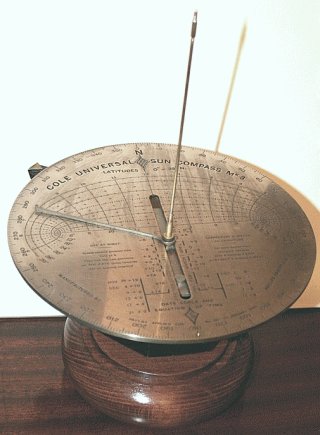
"In 1942, the Free French recce unit at el Alamein was issued with South African built Marmon Herrington Mk 3 armoured vehicles. The Marmon Herrington mounted a sun compass that was made in South Africa by "Philips Orient". That particular sun compass (quite different from the smaller one used by the Long Range Desert Group) was the "Cole universal sun compass Mk3" specially designed to fit latitudes between 0° and 39° N (el Alamein area is 30°30' N)."
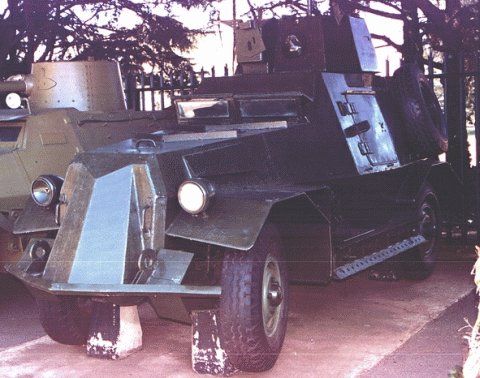
This Marmon-Herrington is at the
SA National Museum of Military History
in Johannesburg where Mr Moné photographed it.
"A Cole Sun Compass Mk3 will be presented to the 1st Spahis Regiment (Free French recce unit) on 21 October 2006 by Free French veterans. The sun compass was found in its original wooden box, but the manual was missing (any electronic copy of the manual will be greatly appreciated!Should anybody wish to contact him, his e-mail is thierry.mone@wanadoo.fr)."
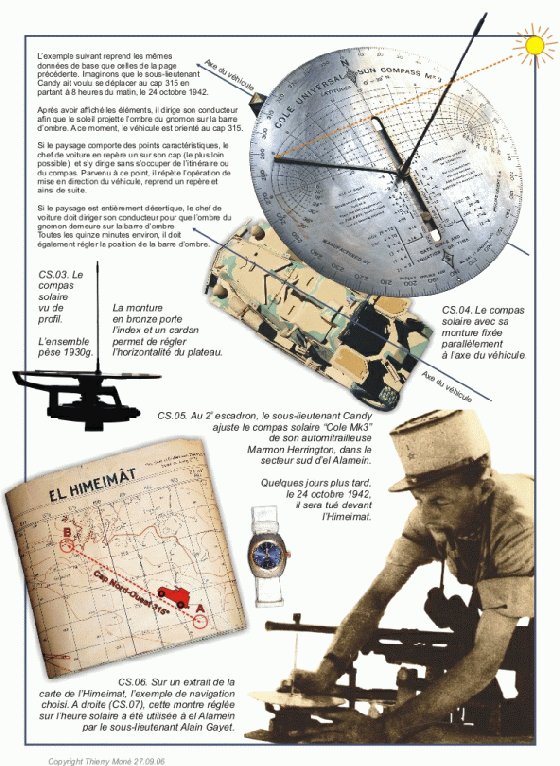
This extract is taken from the book
he is preparing to publish
Return to Journal Index OR Society's Home page
South African Military History Society / scribe@samilitaryhistory.org